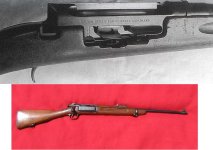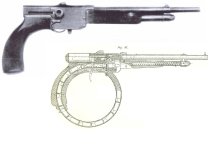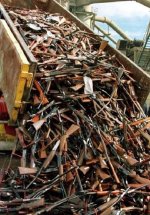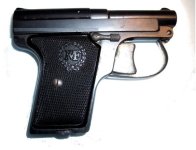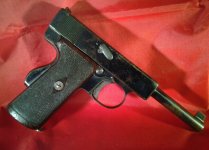You are using an out of date browser. It may not display this or other websites correctly.
You should upgrade or use an alternative browser.
You should upgrade or use an alternative browser.
What the heck
- Thread starter Ozzieman
- Start date
mapsjanhere
New member
Yes, it's a pre-WWI 98 variant. But which one? Hint: Not commercial, and good specimens sell for over $10k.
mapsjanhere
New member
The pattern numbering in the Mauser book is a bit off. The Germans named by intended use, not pattern number like the British. The early ones were the Artillery Model, no bayonet lug but a stacking hook, and the bicycle version without the hook. The one I showed is the "Einheitskarabiner", bayonet lug but no hook. Neither of these models went past troup trials akaik, the first mass produced version was the cavalry model 98a, lug, hook and flat rear sight.
Sorry about that the 98 variant photo was not supposed to be added.
MY BAD
The WINNER IS Ulrice
https://en.wikipedia.org/wiki/Krag–Jørgensen
56 The Krag–Jørgensen is a repeating bolt action rifle designed by the Norwegians Ole Herman Johannes Krag and Erik Jørgensen in the late 19th century. It was adopted as a standard arm by Denmark, the United States of America and Norway. About 300 were delivered to Boer forces of the South African Republic.
A distinctive feature of the Krag–Jørgensen action was its magazine. While many other rifles of its era used an integral box magazine loaded by a charger or stripper clip, the magazine of the Krag–Jørgensen was integral with the receiver (the part of the rifle that houses the operating parts), featuring an opening on the right hand side with a hinged cover. Instead of a charger, single cartridges were inserted through the side opening, and were pushed up, around, and into the action by a spring follower.
The design presented both advantages and disadvantages compared with a top-loading "box" magazine. A similar claw type clip would be made for the Krag that allowed the magazine to be loaded all at once, also known as the Krag "speedloader magazine". Normal loading was one cartridge at a time, and this could be done more easily with a Krag than a rifle with a "box" magazine. In fact, several cartridges can be dumped into the opened magazine of a Krag at once with no need for careful placement, and when shutting the magazine-door the cartridges are forced to line up correctly inside the magazine. The design was also easy to "top off", and unlike most top-loading magazines, the Krag–Jørgensen's magazine could be topped up without opening the rifle's bolt. The Krag–Jørgensen is a popular rifle among collectors, and is valued by shooters for its smooth action.
56 Krag-Jørgensen rifle modified for belt feed
In the factory museum at Kongsberg Weapon Factory, there is preserved an interesting prototype of a M1894 modified for belt feed. Although no documentation has been uncovered, it's clear that the rifle has been modified at an early stage in the manufacturing process to use the same feed belts that were used on the Hotchkiss heavy machine gun in use in the Norwegian Army at the time.
The backward and forward movement of the bolt operates a mechanism that moves the belt through the receiver, presenting fresh rounds for the weapon. While this may have been advantageous while fighting from fixed fortifications, it cannot have been very practical for the user of the rifle to carry a long feed belt with him in the field. Even so, it is an interesting and early attempt to increase the firepower of the Krag-Jørgensen.
MY BAD
The WINNER IS Ulrice
Ozzie, your Krag Jorgensen has been modified to be belt fed.
https://en.wikipedia.org/wiki/Krag–Jørgensen
56 The Krag–Jørgensen is a repeating bolt action rifle designed by the Norwegians Ole Herman Johannes Krag and Erik Jørgensen in the late 19th century. It was adopted as a standard arm by Denmark, the United States of America and Norway. About 300 were delivered to Boer forces of the South African Republic.
A distinctive feature of the Krag–Jørgensen action was its magazine. While many other rifles of its era used an integral box magazine loaded by a charger or stripper clip, the magazine of the Krag–Jørgensen was integral with the receiver (the part of the rifle that houses the operating parts), featuring an opening on the right hand side with a hinged cover. Instead of a charger, single cartridges were inserted through the side opening, and were pushed up, around, and into the action by a spring follower.
The design presented both advantages and disadvantages compared with a top-loading "box" magazine. A similar claw type clip would be made for the Krag that allowed the magazine to be loaded all at once, also known as the Krag "speedloader magazine". Normal loading was one cartridge at a time, and this could be done more easily with a Krag than a rifle with a "box" magazine. In fact, several cartridges can be dumped into the opened magazine of a Krag at once with no need for careful placement, and when shutting the magazine-door the cartridges are forced to line up correctly inside the magazine. The design was also easy to "top off", and unlike most top-loading magazines, the Krag–Jørgensen's magazine could be topped up without opening the rifle's bolt. The Krag–Jørgensen is a popular rifle among collectors, and is valued by shooters for its smooth action.
56 Krag-Jørgensen rifle modified for belt feed
In the factory museum at Kongsberg Weapon Factory, there is preserved an interesting prototype of a M1894 modified for belt feed. Although no documentation has been uncovered, it's clear that the rifle has been modified at an early stage in the manufacturing process to use the same feed belts that were used on the Hotchkiss heavy machine gun in use in the Norwegian Army at the time.
The backward and forward movement of the bolt operates a mechanism that moves the belt through the receiver, presenting fresh rounds for the weapon. While this may have been advantageous while fighting from fixed fortifications, it cannot have been very practical for the user of the rifle to carry a long feed belt with him in the field. Even so, it is an interesting and early attempt to increase the firepower of the Krag-Jørgensen.
While we are waiting for the last one to be answered.
The photo attached shows a new gum. I received insider information and a classified photo of the new gun coming out on November 8.
Your task is to pick who is responsible for the gun in the photo.
The photo attached shows a new gum. I received insider information and a classified photo of the new gun coming out on November 8.
Your task is to pick who is responsible for the gun in the photo.
Attachments
DubC-Hicks
New member
Looks like a pic from the Australian confiscation/turn in program. A sad sight for sure. They could've eradicated their country debt if they would've sold all of the turned in firearms to American importers 
1 Clair M1893 semi automatic pistol. 6 round Handel magazine
http://www.forgottenweapons.com/early-automatic-pistols/clair/
There is very little information other than forgotten weapons. The photo is the only one I can find and none show the magazine.
The French Clair pistol of 1893 is one of the lesser known and least documented early automatic pistols, and unusual in its method of operation as well. The majority of the successful early automatics (the Borchardt/Luger and Mauser in particular) used short recoil mechanisms to unlock, but the Clair was a gas operated design.
The Clair pistol was a design patented and built by three brothers from Saint Etienne – Benoit, Jean Baptiste, and Victor Clair. They submitted their first patent in 1889, which described in general a gas-operating system for firearms. This was followed by a British patent (#15,833) in 1893 for their system, which they claimed was applicable to anything from a pistol up to a rifle, Gatling-style large gun, or even cannon. At least one functional example of their pistol was built, because it was tested (unsuccessfully) against the French Mle 1892 revolver.
The Clair was chambered for the standard French Mle 1892 8mm revolver cartridge (8x27R), and had a barrel approximately 10.5 inches long. Its magazine was a curved tube in the grip which held six cartridges, nose-to-base. Loading and unloading was done through a port below the chamber (in the same location as the ejection port of a Maxim gun). A gas tube was located beneath the barrel, with a gas port 78mm back from the muzzle. The breech is locked by a pivoting wedge that locks into a shoulder cut in the bottom of the frame, between the level of the magazine tube and the bore. Upon firing, the gas piston moves back and allows the wedge to rise out of the locking shoulder and opens the bolt. The travel of the gas piston also operates a cartridge elevator, pushing the next round up from the end of the magazine tube to the level of the bore. A simple recoil spring housed inside the gas piston forces the bolt closed again, loading the next round in the process.
The Clair suffered from a slew of problems during military testing, including failures to feed and fire, and gas leakage. It was also judged to complex to disassemble, too bulky (440mm/17.3in overall length) and too heavy (1.3kg/2.9lb unloaded). We would surmise that when it functioned properly, the weight and low-powered cartridge would give it very pleasant recoil, and the long fixed barrel would make it quite accurate. Unfortunately, we don’t know of any surviving examples of the pistol (although there are at least a few Clair rifles still in existence today).
There is some contention that the Clair actually predated all the other early self-loading pistols, but we don’t believe that is the case. It certainly cannot contend with the Borchardt for the title of first successful self-loader, since is never went into serial production. Furthermore, early Laumann self-loaders exist with proof marks dating to 1891, and there is no evidence that the Clair existed that much earlier than its 1893 patent date.
Bibliography: The Clair: The French Early Self-Loading Pistol, by Clifford Bryant, including translated content by N. Parra. Journal of the Historical Breechloading Smallarms Association, Volume 3 Number 7.
http://www.forgottenweapons.com/early-automatic-pistols/clair/
There is very little information other than forgotten weapons. The photo is the only one I can find and none show the magazine.
The French Clair pistol of 1893 is one of the lesser known and least documented early automatic pistols, and unusual in its method of operation as well. The majority of the successful early automatics (the Borchardt/Luger and Mauser in particular) used short recoil mechanisms to unlock, but the Clair was a gas operated design.
The Clair pistol was a design patented and built by three brothers from Saint Etienne – Benoit, Jean Baptiste, and Victor Clair. They submitted their first patent in 1889, which described in general a gas-operating system for firearms. This was followed by a British patent (#15,833) in 1893 for their system, which they claimed was applicable to anything from a pistol up to a rifle, Gatling-style large gun, or even cannon. At least one functional example of their pistol was built, because it was tested (unsuccessfully) against the French Mle 1892 revolver.
The Clair was chambered for the standard French Mle 1892 8mm revolver cartridge (8x27R), and had a barrel approximately 10.5 inches long. Its magazine was a curved tube in the grip which held six cartridges, nose-to-base. Loading and unloading was done through a port below the chamber (in the same location as the ejection port of a Maxim gun). A gas tube was located beneath the barrel, with a gas port 78mm back from the muzzle. The breech is locked by a pivoting wedge that locks into a shoulder cut in the bottom of the frame, between the level of the magazine tube and the bore. Upon firing, the gas piston moves back and allows the wedge to rise out of the locking shoulder and opens the bolt. The travel of the gas piston also operates a cartridge elevator, pushing the next round up from the end of the magazine tube to the level of the bore. A simple recoil spring housed inside the gas piston forces the bolt closed again, loading the next round in the process.
The Clair suffered from a slew of problems during military testing, including failures to feed and fire, and gas leakage. It was also judged to complex to disassemble, too bulky (440mm/17.3in overall length) and too heavy (1.3kg/2.9lb unloaded). We would surmise that when it functioned properly, the weight and low-powered cartridge would give it very pleasant recoil, and the long fixed barrel would make it quite accurate. Unfortunately, we don’t know of any surviving examples of the pistol (although there are at least a few Clair rifles still in existence today).
There is some contention that the Clair actually predated all the other early self-loading pistols, but we don’t believe that is the case. It certainly cannot contend with the Borchardt for the title of first successful self-loader, since is never went into serial production. Furthermore, early Laumann self-loaders exist with proof marks dating to 1891, and there is no evidence that the Clair existed that much earlier than its 1893 patent date.
Bibliography: The Clair: The French Early Self-Loading Pistol, by Clifford Bryant, including translated content by N. Parra. Journal of the Historical Breechloading Smallarms Association, Volume 3 Number 7.
mapsjanhere
New member
Manufacture Francaise D'Armes Et Cycles De Saint-Etienne
"Le Francais" 6.35 Cal
"Le Francais" 6.35 Cal
mapsjanhere good one.
10 Le Francais police M1922 semi auto pistol 6.35mm
https://en.wikipedia.org/wiki/Le_Français_(pistol)
The Le Français pistol by Manufrance was produced from 1913 till 1969, in a variety of calibres. It was mainly sold in France, primarily to the greater public but also to some officers of the French Army (during the Phony War), and to the French municipal police. In 1912, Etienne Mimard the Head of Manufrance (La Manufacture Française d'Armes et de Cycles de Saint Etienne) started development. Mr. Mimard obtained the patent for the first model (Modèle E) on August 6, 1913 with n° 472.505. Sales started in 1914 with the name "Le Français".
It is loaded through a tip up barrel and after the first shot loads from the magazine. However, the first shot can only be loaded into the barrel since there is no way to manually slide pull. The trigger is double action only. The pistol was the first to function solely in double action.
10 Le Francais police M1922 semi auto pistol 6.35mm
https://en.wikipedia.org/wiki/Le_Français_(pistol)
The Le Français pistol by Manufrance was produced from 1913 till 1969, in a variety of calibres. It was mainly sold in France, primarily to the greater public but also to some officers of the French Army (during the Phony War), and to the French municipal police. In 1912, Etienne Mimard the Head of Manufrance (La Manufacture Française d'Armes et de Cycles de Saint Etienne) started development. Mr. Mimard obtained the patent for the first model (Modèle E) on August 6, 1913 with n° 472.505. Sales started in 1914 with the name "Le Français".
It is loaded through a tip up barrel and after the first shot loads from the magazine. However, the first shot can only be loaded into the barrel since there is no way to manually slide pull. The trigger is double action only. The pistol was the first to function solely in double action.
Mike Irwin
Staff
French Ribylai rifle?
The cartridge appears to be the .351 Winchester necked down to take an 8mm Lebel rifle bullet.
Sent from my SCH-I545 using Tapatalk
The cartridge appears to be the .351 Winchester necked down to take an 8mm Lebel rifle bullet.
Sent from my SCH-I545 using Tapatalk
Mike Irwin
Staff
"French Ribeyrolles M1918 automatic carbine with its 8x35SR cartridge."
Yes! Ribeyrolles, not Ribylai.
During the early years of the war the French bought several thousand Winchester Model 1907 rifles. Some were used in trench warfare, but most were apparently used to arm observers in early aircraft.
Some of them were even modified for fully automatic fire.
The 1907 wasn't particularly reliable in trench warfare conditions, given that it was blowback operated and tended to be sensitive to dirt.
When developing the Ribeyrolles carbine, which was also straight blowback, the French were looking for a more potent cartridge that wouldn't tax the action. The best way to do that was to go with a heavier bullet in the .351 case, hence the slightly necked down 8mm Ribeyrolles incorporating the 198-gr. lathe turned bronze Balle D bullet.
Neither the carbine or the cartridge were much of a success, and with the end of the war both were dropped.
Yes! Ribeyrolles, not Ribylai.
During the early years of the war the French bought several thousand Winchester Model 1907 rifles. Some were used in trench warfare, but most were apparently used to arm observers in early aircraft.
Some of them were even modified for fully automatic fire.
The 1907 wasn't particularly reliable in trench warfare conditions, given that it was blowback operated and tended to be sensitive to dirt.
When developing the Ribeyrolles carbine, which was also straight blowback, the French were looking for a more potent cartridge that wouldn't tax the action. The best way to do that was to go with a heavier bullet in the .351 case, hence the slightly necked down 8mm Ribeyrolles incorporating the 198-gr. lathe turned bronze Balle D bullet.
Neither the carbine or the cartridge were much of a success, and with the end of the war both were dropped.


